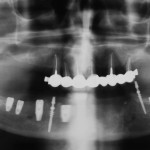
Periodontal disease is an important cause of tooth loss and dental implants have become an increasingly popular method of replacing missing teeth. This raises the question as to whether patients who are prone to periodontal disease are at greater risk of peri-implant disease and implant loss.
The aim of this review was to compare the failure rates of dental implants placed in periodontally compromised patients with those placed in periodontally healthy patients
Methods
Searches were conducted in the PubMed, Web of Science, and the Cochrane Oral Health Group Trials Register databases. This was supplemented with manual searches of a number of dental implant related dental journals and the reference lists of identified studies. Human clinical studies that compared implant failure rates in periodontally health and periodontally compromised patients were considered. Implant failure was considered to be the complete loss of the implant. Study selections was carried out independently by 3 reviewers and study quality was assessed using the Newcastle–Ottawa scale (NOS)
Results
- 22 studies involving 5533 patients with 16808 implants were included;
- 10 were clinical controlled trials and 12 retrospective studies.
- Follow up periods ranged from 1 month to 16 years
- Failure rates varies from 0 to 25%
- Overall 10,927 implants were placed in periodontally compromised patients with 587 (5.37%) failures. With 5881 implants placed in periodontally healthy patients and 226(3.84%) failures
- Relative risk (RR) of failure if implants inserted into periodontally compromised patients
- For all 22 studies RR = 1.78 (95% CI; 1.50- 2.11)
- For 10 CCT studies only RR = 1.97 (95% CI; 1.38–2.80)
- RR of postoperative infection compared with periodontally healthy patients = 3.24, (95% CI 1.69-6.21)
- Marginal bone loss favoured periodontally health patients mean difference = 0.60, (95% CI; 0.33-0.87)
Conclusions
The authors concluded
The results of the present systematic review should be interpreted with caution due to the presence of uncontrolled confounding factors in the included studies, none of them randomized. Within the limitations of the existing investigations, the present study suggests that an increased susceptibility for periodontitis may also translate to an increased susceptibility for implant loss, loss of supporting bone, and postoperative infection.
Commentary
No randomised trials were located by the search and the majority of identified studies were retrospective so have a higher potential for bias, in particular selection bias. Study quality was assessed using NOS with all studies scoring at least 5 (out of 9). In the discussion the authors noted a range of different definitions for periodontal disease, general issues with reporting and raise concerns as to whether all confounders are taken into account. The authors’ cautionary conclusion should therefore be heeded.
Earlier this year we reported a review (Dental Elf 16th Jan 2014) that looked at periodontitis as a risk factor for peri-implantitis and implant loss. They only included prospective cohort studies ( 14 in all ) and suggested that there was strong evidence that periodontitis was a risk factor for implant loss with moderate evidence that patients with periodontitis have higher implant-bone loss. However at the time I thought that this might be overstating the available evidence
Links
Chrcanovic BR, Albrektsson T, Wennerberg A. Periodontally compromised vs. periodontally healthy patients and dental implants: A systematic review and meta-analysis. J Dent. 2014 Oct 2. pii: S0300-5712(14)00274-7. doi: 10.1016/j.jdent.2014.09.013. [Epub ahead of print] PubMed PMID: 25283479.

Opmerkelijke conclusie. “@TheDentalElf: Dental Implants: failure rates higher in periodontally compromised patients..http://t.co/61I1BWHFJu”
SR finds higher dental implant failure rate in periodontally compromised patients than in healthy ones http://t.co/peG4PayyaW
Don’t miss – Dental Implants: failure rates higher in periodontally compromised patients… http://t.co/peG4PayyaW
[…] Dental Elf 7th Nov 2014 – Dental Implants: review suggests failure rates higher in periodontal… […]
[…] Dental Elf – 7th – Nov 2014- Dental Implants: review suggests failure rates higher in pe… […]